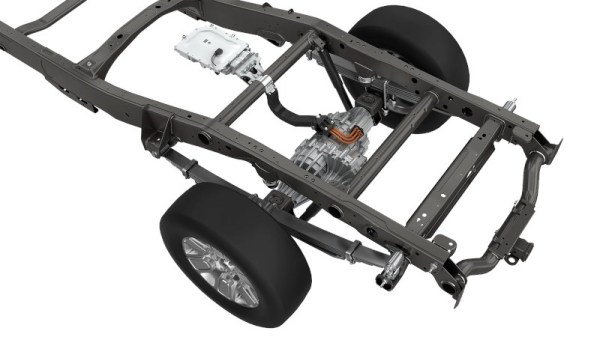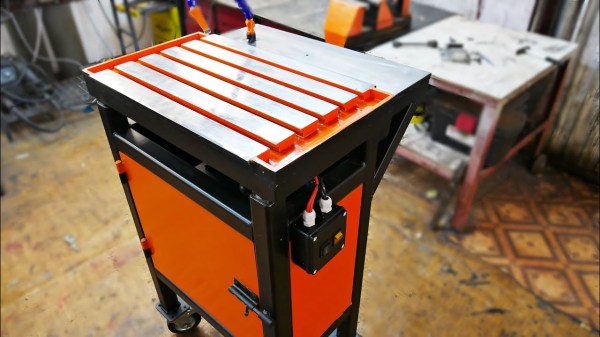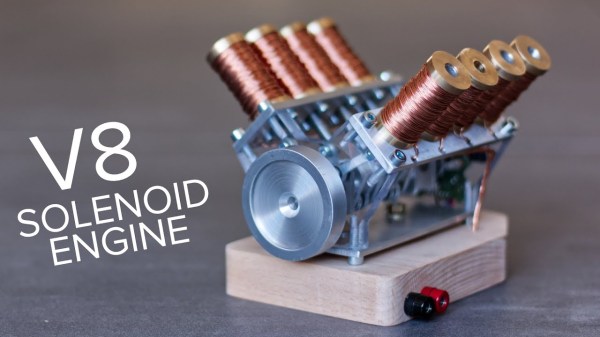Thus far, the majority of electric cars on sale have been aimed at commuters, fitting into the sedan and SUV segments of the marketplace. Going forward, there’s a very real need for electrification to touch the whole spectrum of automobiles, and that includes work vehicles like pickup trucks. A company called Magna have recently thrown their hat into the ring in just this space, developing a simple drivetrain that can be readily installed in pickup trucks without major modifications. Continue reading “Magna Announces Simple Drive Solution For Electric Pickup Trucks”
electric85 Articles
Inside Smart Meters Hack Chat
Join us on Wednesday, April 14 at noon Pacific for the Inside Smart Meters Hack Chat with [Hash]!
That electrical meter on the side of your house might not look like it, but it’s pretty packed with technology. What was once a simple electromechanical device that a human would have to read in person is now a node on a far-flung network. Not only does your meter total up the amount of electricity you use, but it also talks to other meters in the neighborhood, sending data skipping across town to routers that you might never have noticed as it makes its way back to the utility. And the smartest of smart meters not only know how much electricity you’re using, but they can also tease information about which appliances are being used simply by monitoring patterns of usage.
While all this sounds great for utility companies, what does it mean for the customers? What are the implications of having a network of smart meters all talking to each other wirelessly? Are these devices vulnerable to attack? Have they been engineered to be as difficult to exploit as something should be when it’s designed to be in service for 15 years or more?
 These questions and more burn within [Hash], a hardware hacker and security researcher who runs the RECESSIM reverse-engineering wiki. He’s been inside a smart meter or two and has shared a lot of what he has learned on the wiki and with some in-depth YouTube videos. He’ll stop by the Hack Chat to discuss what he’s learned about the internals of smart meters, how they work, and where they may be vulnerable to attack.
These questions and more burn within [Hash], a hardware hacker and security researcher who runs the RECESSIM reverse-engineering wiki. He’s been inside a smart meter or two and has shared a lot of what he has learned on the wiki and with some in-depth YouTube videos. He’ll stop by the Hack Chat to discuss what he’s learned about the internals of smart meters, how they work, and where they may be vulnerable to attack.
 Our Hack Chats are live community events in the Hackaday.io Hack Chat group messaging. This week we’ll be sitting down on Wednesday, April 14 at 12:00 PM Pacific time. If time zones have you tied up, we have a handy time zone converter.
Our Hack Chats are live community events in the Hackaday.io Hack Chat group messaging. This week we’ll be sitting down on Wednesday, April 14 at 12:00 PM Pacific time. If time zones have you tied up, we have a handy time zone converter.
Click that speech bubble to the right, and you’ll be taken directly to the Hack Chat group on Hackaday.io. You don’t have to wait until Wednesday; join whenever you want and you can see what the community is talking about.
Continue reading “Inside Smart Meters Hack Chat”
Improving More Leaf Design Flaws
[Daniel] was recently featured here for his work in improving the default charging mode for the Nissan Leaf electric vehicle when using the emergency/trickle charger included with the car. His work made it possible to reduce the amount of incoming power from the car, if the charging plug looked like it might not be able to handle the full 1.2 kW -3 kW that these cars draw when charging. Thanks to that work, he was able to create another upgrade for these entry-level EVs, this time addressing a major Leaf design flaw that is known as Rapidgate.
The problem that these cars have is that they still have passive thermal management for their batteries, unlike most of their competitors now. This was fine in the early ’10s when this car was one of the first all-electric cars to market, but now its design age is catching up with it. On long trips at highway speed with many rapid charges in a row the batteries can overheat easily. When this happens, the car’s charging controller will not allow the car to rapid charge any more and severely limits the charge rate even at the rapid charging stations. [Daniel] was able to tweak the charging software in order to limit the rapid charging by default, reducing it from 45 kW to 35 kW and saving a significant amount of heat during charging than is otherwise possible.
While we’d like to see Nissan actually address the design issues with their car designs while making these straighforward software changes (or at least giving Leaf owners the options that improve charging experiences) we are at least happy that there are now other electric vehicles in the market that have at least addressed the battery thermal management issues that are common with all EVs. If you do own a Leaf though, be sure to check out [Daniel]’s original project related to charging these cars.
’54 Motorcycle Saved By Electric Conversion
While it’s nice to be able to fully restore something vintage to its original glory, this is not always possible. There might not be replacement parts available, the economics of restoring it may not make sense, or the damage to parts of it might be too severe. [onyxmember] aka [Minimember Customs] was in this position with an old ’54 Puch Allstate motorcycle frame that he found with no engine, rusty fuel tank, and some other problems, so he did the next best thing to a full restoration. He converted it to electric.
This build uses as much of the original motorcycle frame as possible and [onyxmember] made the choice not to weld anything extra to it. The fuel tank was cut open and as much rust was cleaned from it as possible to make room for the motor controller and other electronics. A hub motor was laced to the rear wheel, and a modern horn and headlight were retrofitted into the original headlight casing. Besides the switches, throttle, and voltmeter, everything else looks original except, of course, the enormous 72V battery hanging off the frame where the engine used to be.
At a power consumption of somewhere between three and five kilowatts, [onyxmember] reports that this bike likely gets somewhere in the range of 55 mph, although he can’t know for sure because it doesn’t have a speedometer. It’s the best use of an old motorcycle frame we can think of, and we also like the ratrod look, but you don’t necessarily need to modify a classic bike for this. A regular dirt bike frame will do just fine.
Continue reading “’54 Motorcycle Saved By Electric Conversion”
Custom Drill Press Table Eliminates Hassles
Getting a perfect workshop together, with all the right tools, is a dream for many. A lot of us cobble together what we can with a dremel tool, a soldering iron, and whatever work surface happens to be available in the kitchen or spare bedroom. But even when we finally get a permanent garage or shop to work in, there are still some challenges to overcome with our workspaces. [Workshop From Scratch] was having issues with his drill press, and solved them with this custom build.
Rather than modify an existing press, he first welded a table together from scratch using square tube. From there he set about solving those issues. The first was having to make a large number of adjustments up and down when working on larger pieces. For that he added an electrically adjustable worktop which keeps him from having to make constant adjustments of the press itself. The second improvement over the standard press workspace was adding a cooling system for the cutting tools, saving himself money in bits and allowing quicker drilling.
The finished product looks professional thanks to a quality paint job and, of course, having all the right tools in the workshop in the first place to put something like this together. We all have an idea in our heads about the perfect workshop for our own needs, but don’t forget to think outside the box when it comes to building one yourself.
Continue reading “Custom Drill Press Table Eliminates Hassles”
This V8 Makes A Shocking Amount Of Power
As a work of art, solenoid engines are an impressive display of electromagnetics in action. There is limited practical use for them though, so usually they are relegated to that realm and remain display pieces. This one from [Emiel] certainly looks like a work of art, too. It has eight solenoids, mimicking the look and internal workings of a traditional V8.
There’s a lot that has to go on to coordinate this many cylinders. Like an internal combustion engine, it takes precise timing in order to make sure that the “pistons” trigger in the correct order without interfering with each other through the shared driveshaft. For that, [Emiel] built two different circuit boards, one to control the firing of each solenoid and another to give positional feedback for the shaft. That’s all put inside a CNC-machined engine block, complete with custom-built connecting rods and shafts.
If you think this looks familiar, it’s because [Emiel] has become somewhat of an expert in the solenoid engine realm. He started off with a how-to for a single piston engine, then stepped it up with a V4 design after that. That leaves us wondering how many pistons the next design will have. Perhaps a solenoid version of the Volkswagen W12?
DIY Lawnmower Doesn’t Cut Grass Short
[nodemcu12ecanada] is serious about saving water, which is why they built this strange lawnmower that can cut grass taller.
Short lawns are one of those clever marketing victories, like convincing people to eat a lot of sugar, that’s been doing more harm than good ever since the victory was won. Short grass is weak grass, with shallow roots, weakness to weeds, and a lot of water requirement. On top of that the grass is always in a state of panic so it grows extra fast to get to a more “natural” height. It’s great if you want to sell fertilizer, seeds, and lawnmowers. Maybe not so great for the environment.
Most lawnmowers can’t even be set high enough for healthy grass so [nodemcu12ecanada] took three electric weed whackers and bolted them to an angle iron frame. It has a lot of advantages. It’s light. You don’t need to sharpen a blade. It’s quiet. It’s electric. It’s strange appearance will scare your neighbors off from borrowing any of your tools. We love it!

















